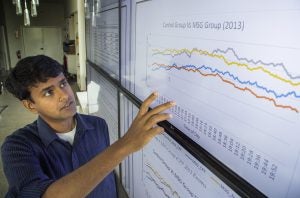D.C. Circuit Extends Pause in Litigation on Carbon Pollution Standards for New Power Plants
The U.S. Court of Appeals for the D.C. Circuit announced that it will extend a pause in litigation over America’s[…]
Read moreDedicated To People, The Planet, and All Its Inhabitants – Since 1996

The U.S. Court of Appeals for the D.C. Circuit announced that it will extend a pause in litigation over America’s[…]
Read moreIt’s tough to even know where to start with this one, but here goes.
A company called Impossible Foods, with $257 million in venture capital funding, recently launched its fake, genetically engineered Impossible Burger—even though, the FDA (supposedly in charge of food safety) can’t say if the burger’s “secret sauce”—soy leghemoglobin—is safe.
How can Impossible Foods put soy leghemoglobin in food if the FDA hasn’t deemed it safe? The New York Times explains:
The F.D.A.’s approval is not required for most new ingredients. Companies can hire consultants to run tests, and they have no obligation to inform the agency of their findings, a process of self-affirmation.”
While you let that sink in . . . here’s the other half of that story. Impossible Foods asked the FDA to weigh in on the safety of its “secret sauce” ingredient, even though it wasn’t required to. The agency did. This is what regulators wrote in a memo to Impossible Foods:
“F.D.A. believes the arguments presented, individually and collectively, do not establish the safety of soy leghemoglobin for consumption,” nor do they point to a general recognition of safety.”
Despite that statement, the Impossible Burger went to market. Because, as it turns out, a company can introduce into the food system a product or ingredient that the FDA says may not be safe—as long as the FDA doesn’t say the product is unsafe.
That’s one issue with the Impossible Burger. Here’s the other. According to Max Goldberg, author of “Living Maxwell,” Impossible Foods uses genetic engineering to make the secret sauce that the FDA won’t say is safe. In his column, which appeared on the same day as the New York Times article, Goldberg raised the question of genetic engineering, and whether Impossible Foods is misleading consumers. Goldberg explains how the Impossible Burger is made:
On August 10th, the Trump Administration announced a plan to throw America’s Clean Car Standards into reverse, imperiling climate security[…]
Read more
Reviewing residential electricity data in Pecan Street’s Pike Powers Lab.
By Maddie Venn, clean energy communications intern
Recently, it seems like everyone is competing to become the next big thing in the energy sector. Whether it’s electric vehicles, smart grid technology, or energy storage, innovation continues to pop up left and right as we work to build a smarter, cleaner electric grid.
If innovation and technology spark your competitive drive, here’s your opportunity to dive in and join a community of engaged researchers working to solve some of our most pressing energy concerns. Pecan Street is hosting its second student research competition, inviting the best and the brightest to use the organization’s extensive collection of energy-use data to help solve real-world problems.
Open to all full-time graduate and undergraduate students and with prizes totaling $10,000, the competition aims to connect Pecan Street’s well-established dataset with the innovation of young minds. As the grid gets smarter, data can help people play a more active role in how their electricity is made, moved, and used. Competitions like Pecan Street’s will get us there faster.
What is Pecan Street?
Founded in Austin, Texas with the goal of better understanding the behavior of energy users, Pecan Street’s research network provides the most granular understanding of electricity and water use on the planet. The organization is collecting massive amounts of anonymized data in real time from thousands of houses across the nation, providing a near-constant stream of data on water and energy use.
Research competition invites students to solve real-world energy problems
Click To Tweet
The data collected at these different sites is compiled and made available to university researchers around the world interested in finding out more about the way people interact with the grid. With this information, the possibilities for discovery and innovation are seemingly endless, presenting both a challenge and an opportunity to all interested researchers.
The competition
To help spark some of these new and innovative ideas, competition organizers have provided a list of potential research topics that may be of interest to students, including:
Each suggested topic can serve as a jumping off point for research that can have significant real world implications. While it is recommended that researchers utilize these suggested topics, it is not required.
In a previous competition, the student who won first prize used Pecan Street’s dataset to ease the pressure that residential air conditioning puts on the grid. Using a centralized control, the winner created a system to adjust thermostats and distribute use throughout the day. This cuts pollution by reducing the need for costly, dirty “peaker” plants, which operate only a few hours each year when demand is high (like on a hot summer afternoon when many people simultaneously crank up the AC).
In a previous competition, the student who won first prize used Pecan Street’s dataset to ease the pressure that residential air conditioning puts on the grid.
The opportunity for discovery with this next round of competition grows even larger as Pecan Street expands its testbed and data collection.
Interested?
Visit Pecan Street’s website for more information and suggested research topics. All proposals must be submitted to info@pecanstreet.org by January 30, 2018 to be considered. Four finalists will be selected and flown to Austin to present their research at Pecan Street’s annual research conference, with the chance to win big and get involved with this up-and-coming research community.
Smart grid technology is already transforming our energy system, and there has never been a better time to get involved in this fast-growing industry. The future of the national grid may be impacted by the work that comes out of this competition, and you could be influential in the next wave of energy innovation.
This post originally appeared on Energy Exchange blog.
Saturday, August 12, 2017
Read moreThe full U.S. Court of Appeals for the D.C. Circuit rejected the latest attempt to undermine pollution limits for sources[…]
Read moreThe U.S. Environmental Protection Agency (EPA) has released information on more than 1,900 climate-related web pages and files that were[…]
Read more
This year’s Farm Bill presents an opportunity for Congress to pass several animal protection bills, two of which — the PAST Act and the SAFE Act — would take great strides to improve the lives of horses. Photo by Ashlei Martin/Black Beauty Ranch
Americans shouldn’t butcher dogs or horses, or enable the activity, and then sell the meat for human consumption, and Congress can make that the law of the land as it pieces together the far-flung provisions of the Farm Bill in the coming months. Our thriving agricultural sector is successful enough that we as a nation . . .
The post Farm Bill should ban eating dogs and horses, along with instituting other key animal welfare reforms appeared first on A Humane Nation.

Amid a dire poaching crisis, wild Asian elephants in Myanmar received swift and essential aid from thousands of WWF supporters committed to protecting this iconic species. More than 3,000 people donated $263,211 in less than four weeks to fund an emergency action plan to train rangers and get boots on the ground to fight wildlife crime.
Read moreBy EDF Blogs
By Elizabeth Villedrouin, Communications Intern, Clean Energy and Kristen Moore, Research Intern, Clean Energy
 As interns at Environmental Defense Fund (EDF), we’ve been tapped as resident experts on surviving on college budgets, social media, and all things Millennial. Research tells us Millennials are the largest living generation. So, as Clean Energy interns this summer, we’ve learned that gives us much power to change the game for the energy sector. But in unexpected ways.
As interns at Environmental Defense Fund (EDF), we’ve been tapped as resident experts on surviving on college budgets, social media, and all things Millennial. Research tells us Millennials are the largest living generation. So, as Clean Energy interns this summer, we’ve learned that gives us much power to change the game for the energy sector. But in unexpected ways.
As young people, we’re working at EDF because we want to promote systemic, market-based solutions and new energy technologies that shift our country toward a clean energy future and away from our fossil fuel past (did someone say solar paint?).
We have high standards for our energy future, and our priorities differ from our parents’ (for example, millennials tend to value careers [PDF] over religious life). And although we’re the thriftiest generation, 64 percent of us are actually willing to pay more on our electric bill if it’s generated by clean energy.
Shifting the economy
Although a generation that has been slow to invest, millennials are now buying stocks in companies that further the clean energy economy. Among millennials’ favorite stocks are companies like Apple and Facebook who declared their commitment to rely on 100 percent renewable energy through RE100. Others include Amazon, which launched four wind and solar farms in 2016 and publicly supported the Clean Power Plan; Tesla, which started selling solar panels this year; and Nvidia, which plans to reduce emissions by 15 percent per employee by 2020 and only operates in buildings that comply with LEED standards.
The energy sector needs to adapt to millennials—not vice versa
Click To Tweet
We like to put our money where our values are. Our generation is the most likely to pay more for responsibly made products and roughly 80 percent of us want to work for companies that care about their impacts. Nearly 400,000 millennials are currently working in green jobs.
Energy-efficient lifestyles
For a variety of economic and social factors, our lifestyles tend to be more energy efficient. Many of us are choosing buses and bikes over cars. And we’re more likely to purchase new, energy-saving products and services like Nest learning thermostats than people over 55, according to research by Accenture.
“Energy providers must take these and other insights about these groups to heart, to unlock value, because consumers’ preferences and behaviors are rapidly changing the market landscape,” said Tony Masella, managing director of Accenture Energy Consumer Services.
Appeal to our drive for progress and prosperity based on clean, equitable energy solutions.
Push-back against fossil fuels
Students from hundreds of colleges and universities have led successful movements urging their administrative leaders to divest from fossil fuels. Educational institutions make up 14 percent of the approximate $5.42 trillion value of institutions around the world that have divested from the fossil fuel industry. 600 colleges and universities are already members of the Climate Leadership Network, a network of institutions committed to action plans to achieve carbon-neutrality in the coming future. But, for some students, these commitments mean nothing if their schools are still buying stock in fossil fuels, even if the financial impact to the industry is slim.
Our advice: Don’t sleep on us
In order to thrive, today’s energy sector should engage its youngest customers – which happen to be America’s most tech-savvy, environmentally conscious generation. Attempts to garner support for fossil fuel would be like Sony trying to sell us Walkmans –futile. Appeal to our drive for progress and prosperity based on clean, equitable energy solutions. More and more, we are the ones making important energy decisions –as building managers, homeowners, engineers, utility regulators, and, one day, the next head of the Department of Energy.
Photo source: wundervisuals